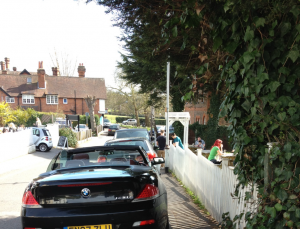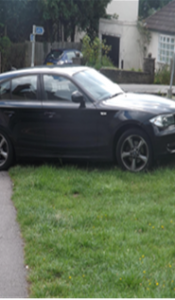New proposals for Hills parking
 Consultation period will follow publication
Consultation period will follow publication
Following last year’s parking consultation with residents, the North Essex Parking Partnership have identified several parking issues in the Hills area and intend to publish plans to resolve these shortly before a consultation period on the changes.
 A residents’ parking permit scheme was decided against as a remedy to current problems after the initial consultation. Instead, residents identified key areas that needed attention through more targeted, smaller scale restrictions such as double yellow lines in key areas.
A residents’ parking permit scheme was decided against as a remedy to current problems after the initial consultation. Instead, residents identified key areas that needed attention through more targeted, smaller scale restrictions such as double yellow lines in key areas.
Details have not yet been finalised but Shane Taylor at the North Essex Parking Partnership said
“It is envisaged that the planning for those roads will be completed and finalised shortly after the Easter break which will provide adequate time for the commencement of the consultation period.
Our pictures show some of
the parking by selfish drivers
around York Hill and Staples Road
“The changes will be advertised once they are ready which will include an official consultation period where comments, including objections could be heard.”
Thank you to all Hills residents who participated in the North Essex Parking Partnership’s residents’ parking survey. It has helped the partnership to understand and deal with the parking issues in the area. The partnership has informed Loughton Council that most people voted against implementing residents’ parking. Therefore, residents’ parking will not be put in place. Instead, residents reported specific problems that they felt would not be solved by introducing residents’ permits. Following this feedback the partnership will be implementing specific parking restrictions to deal with these reported problems. No details have been decided yet but we will keep you informed.
During the consultation stage, the Hills Committee met with Technical Team Leader Shane Taylor of the North Essex Parking Partnership to discuss proposals for residents’ parking restrictions in the Staples Road, Queens Road and York Hill areas on 16 April. The meeting was also attended by County Councillor Chris Pond among a limited number of invited representatives.
Shane told the committee that the residents parking proposal had come about as a result of specific complaints being made by a number of residents. In particular these concerned cars parking at the bottom of Forest Way causing obstruction to vehicles entering and exiting the road; parking and waiting vehicles at the bottom of York Hill causing obstructions in the road and on the pavement; and congestion and illegal parking on Staples road and School Green due to school traffic.
‘None of these issues would be resolved by a residents’ parking scheme’
He said that in his professional opinion none of these issues would be resolved by a residents’ parking scheme.
In discussion potential solutions for these specific complaints were discussed. These might include double yellow lines at bottom of road Forest Way. Double yellow lines and enforcement by parking authorities and police at the bottom of York hill. However based on revidence from other schools there was no real solution to the problem of parking around the school, particularly at dropping off and picking up times.
Issues around shoppers parking in Staples Road and the junction of Pump Hill and Queen’s Road along with a general problem of not enough spaces for residents had led NEPP in consultation with Epping Forest District Council to propose residents’ parking along with particular measures such as yellow lines.
There was consensus in the meeting that residents parking would not solve the issues raised. Some issues such as general overcrowding could not be solved like this as the vast majority of the cars are owned by residents. Shane agreed with this assessment.
It was agreed that commuter parking was not the issue in this area at the moment. Other localised issues such as Forest Way and Pump Hill could be solved by yellow lines and the school problem was best addressed by working with the school. Chris Pond, Shane Taylor and Alison Trauttmansdorff, a school governor, agreed to talk to the school to raise this.
Shane explained the proposal process and noted that the proposal would be based on the feedback he received. Residents’ parking may not be imposed if the conclusion is that it would not help.
The current ‘informal’ consultation stage was being held before any decisions on a solution had been made. NEPP would not start to design the scheme until all residents had been given the opportunity to voice opinions. Any resulting scheme would be based on this feedback.
Important residents make opinions known
This meant it was important that residents made their opinions known now at the ‘informal’ questionnaire stage so NEPP could make a decision on whether there should be full residents’ parking or a scheme more appropriate to the area’s needs.
If the majority of residents did want some form of parking restrictions (residents parking or otherwise) NEPP would advertise the proposal with full details to all residents and there would be 21 days to object to any detail. The proposal would then be redesigned to resolve outstanding issues.
Shane told the committee that NEPP and LRA were very conscious of conservation needs of the area. Any implementation would have to take this into account and all residents, the Hills Society and the district council would have the opportunity to comment on any proposal.
It was also mentioned that residents’ parking or restriction in general could lead to residents creating more drive ways and removing protected hedges etc, meaning that the area would lose its feel and become harder to conserve.
Residents parking would potentially mean a need for pay and display or waiting bays but NEPP would endeavour to keep street furniture and markings to a minimum, such as signs only at the entrances to the area.
There was no set timeline for implementation. The larger the proposal the longer it would take. If a small solution of only double yellow lines in certain places were adopted then this would take less time to put in place.
If no proposal was taken forward it was not unusual for an area not to be considered for another five years because of limited resources. But at the same time it was important to make the right decision so residents did not have to live with restrictions that were a disadvantage to the area for the next five years.
Stephen Cohen, chairman-elect of the committee said: “It is hoped this information will help residents make a decision and residents are urged to reply to the questionnaire and give their feedback at this stage so the most appropriate action can be taken. Please share this information with fellow residents.”
Questions and answers
Shane Taylor had previously responded to questions put to him by the Hills committee (in green)
1. Could you give a brief outline of the steps to the whole process, including the ‘informal’ and ‘formal’ stages and highlighting at what steps:
At this current time we are merely ascertaining the general views/opinions regarding the introduction of a residents parking scheme or leaving things as they are. Depending on the results of the survey, we will then decide, in conjunction with the District Council if a scheme will be progressed to an official design stage or if no further action will be taken.
If majority support is available we would then arrange for the necessary advertising and formal consultation which would involve lettering residents again with details of a scheme, including information such as the position of signs and lines for example. This period lasts for 21 days and objections are viewed and answered within this time period. If objections are received they would be considered and if necessary amendments to a plan may be required. If amendments were considered to be above and beyond those planned then re-advertising would need to occur and a further 21 day consultation period adhered to. As you can see this can “drag” the time that schemes take to implement considerably and in some cases, schemes may be withdrawn if too many objections are received. If we advertise our intention to install a scheme or restrictions, after successfully answering objections but a party is still not happy with our response or plans they can challenge this in the High Court in the form of a judicial review. As you can see these matters can become quite complicated and there are numerous scenarios which can occur. We are not legally obliged to install restrictions or schemes however we can be legally challenged once we state our intentions to complete work. If we successfully answer objections and are not challenged we then advertise the fact that we intend to install a scheme etc which would then lead to the installation of the design elements such as signs and lines and enforcement would occur once this has been completed.
2. Will residents be able to feedback and vote on the project continuing/residents parking being implemented?
This will depend on the results of the survey which is currently being conducted and this is seen as an opportunity to have a say on whether further investigation/work is warranted.
3. Will Epping Council be able to input on conservation requirements?
This would need to be considered if a scheme is progressed.
4.Please explain the context of what is being proposed – why it is being proposed and the sorts of complaints you were receiving
We have received complaints from various parties from a number of the roads being surveyed and need to consider the area holistically as restrictions in one road will affect others if they too are not included. Complaints relate to access issues for larger vehicles, driveway/road obstructions/non resident based parking/school based parking
5. Will there be an opportunity for an alternative solution to be considered if residents’ parking is not found to be appropriate. Would this opportunity be available if residents vote no at this stage?
Unfortunately we have consulted with the District Council and ward members and the two options detailed on the questionnaire are seen as the only two available in this scenario. Our work has had to gain the approval of the parking partnership board (consists of Harlow, Tendring, Braintree, Epping Forest, Uttlesford District Councils & Colchester Borough Council) due to the significant work required. Similar consultations have occurred elsewhere and future work is very much controlled by the responses we receive. We may consider nominal changes in locations where additional lines may be needed to prevent any parking such as the entrance to Forest Way and certain parts of York Hill.

Comments are closed.